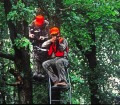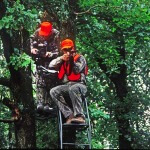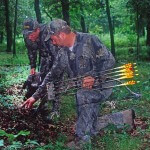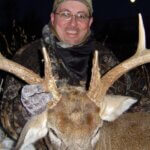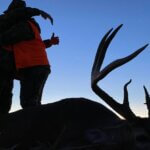Both David Blanton and Troy Ruiz mention that most amateur videographers don’t shoot enough beauty shoots, for example, slow, wide-angle shots of the land around the areas you plan to hunt. Slowly panning lets the viewer see where you’re hunting, what the terrain looks like and why you’ve chosen this spot to hunt. Here are some other things amateur videographers do wrong:
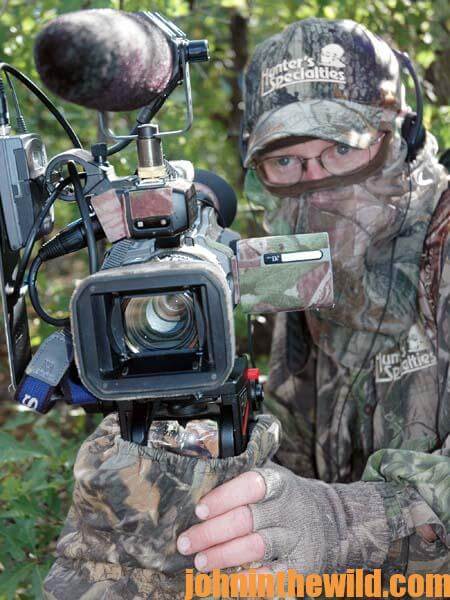 1) The cameraman goes to his stand site with a wrong wind.
1) The cameraman goes to his stand site with a wrong wind.
He thinks because he’s wearing odor eliminator that he won’t spook the deer he’s hoping to video. But never go to a stand site in a bad wind. Even the equipment you carry with you into the woods and the tree stand will have odor on it that deer can detect. (David Blanton)
2) The videographer takes his eye off the camera and starts looking for an animal he can’t see through the view finder. Then with the tape still running, he puts his eye back on the eyepiece and tries to move the camera around to locate the game. Instead, look over the top of your camera instead of to the left of it when you lose the animal in the viewfinder. Using this technique, when you come down to your eye or up to your eye with your camera, your eye and your camera lens will both be in line with the game you’re trying to photograph. (Troy Ruiz)
3) Most people zoom in too tight on the deer when they video their hunts. If a cameraman zooms in really tight on the deer, and the hunter takes the shot, most of the time the deer will jump out of the frame. But, if you stay wide on the deer when the hunter takes the shot, you can follow the deer after the shot. You also can see better when the hunter hits the deer. (David Blanton)
4) The cameraman uses old tapes to video a hunt. When you push the STOP button on your camera, the tape inside the camera still may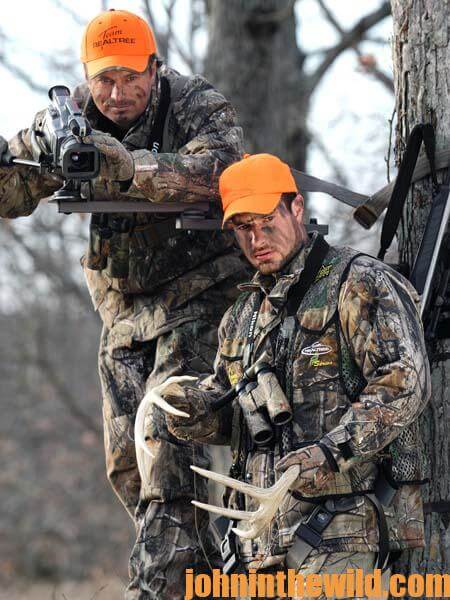 move from one to 10 frames forward before it stops recording. Then when you push the ON button, the tape may move from one to 10 frames forward before it actually starts recording. Because of this, whatever you’ve taped before you’ve gone on the hunt will appear in the video when you play it back. You may show a deer walking toward the hunter and right in the middle of the scene see frames of a youngster’s blowing out birthday candles. Always use new tapes when you video your hunt. Make sure you label your tape, and push the non-erase tab in to keep you from videoing over your hunting tape. (Troy Ruiz)
move from one to 10 frames forward before it stops recording. Then when you push the ON button, the tape may move from one to 10 frames forward before it actually starts recording. Because of this, whatever you’ve taped before you’ve gone on the hunt will appear in the video when you play it back. You may show a deer walking toward the hunter and right in the middle of the scene see frames of a youngster’s blowing out birthday candles. Always use new tapes when you video your hunt. Make sure you label your tape, and push the non-erase tab in to keep you from videoing over your hunting tape. (Troy Ruiz)
5) The video is out of focus. Focus your camera manually instead of using the camera’s automatic focus for best results. (David Blanton)
6) The cameraman zooms in too close in the early morning and the late afternoon, and you can’t see the shots because of the darkness. Don’t use a zoom in the early morning or late afternoon, because the more you zoom, the less light the lens can gather. (Troy Ruiz)
7) The videographer doesn’t zoom out when he moves the camera from one animal to another. Zoom in and focus on one animal; then zoom out and move to the other animal before zooming in and focusing. (David Blanton)
8) The videographer shoots at times when he doesn’t have enough light. Purchase a camera light. If the hunter takes a shot late in the afternoon, an inexpensive camera light will allow you to show the recovery. If I had to pick one accessory for a camera that would really increase the quality of the video, I’d choose a camera light. (Troy Ruiz)
 9) The videographer hasn’t edited his film or used cutaways. Make your video tell a story, and edit the video to get top quality. Shoot some really good cutaways, a recreation of the event. For instance, you may want to zoom in on the hunter’s eyes and have the hunter recreate his emotions when he’s spotted the deer or turkey, mounted his gun, etc. to build drama in a video. Get wide shots and close-ups of the hunter too to intersperse in the video. (David Blanton)
9) The videographer hasn’t edited his film or used cutaways. Make your video tell a story, and edit the video to get top quality. Shoot some really good cutaways, a recreation of the event. For instance, you may want to zoom in on the hunter’s eyes and have the hunter recreate his emotions when he’s spotted the deer or turkey, mounted his gun, etc. to build drama in a video. Get wide shots and close-ups of the hunter too to intersperse in the video. (David Blanton)
10) The video has difficult-to-understand audio. Use a quality mic like a directional mic. Don’t rely solely on the mic built into the camera, since camera noise will affect it. Set-up a directional mic, which will pick-up sound in a 90-degree arc, away from the camera by hanging it on a bush or in a tree. Never lay it on the ground. (Troy Ruiz)
11) The cameraman positions himself in front of the downed game and videos the hunter as he walks up to the game, something that never will happen in real life. Instead, walk behind the hunter as he moves to the deer or the turkey to recover the game to make your video more lifelike and accurate. (Ruiz and Blanton)
To learn more about deer hunting, you can get John E. Phillips’ Kindle eBooks, “How to Hunt Deer Up Close: With Bows, Rifles, Muzzleloaders and Crossbows,” “PhD Whitetails: How to Hunt and Take the Smartest Deer on Any Property,” “How to Take Monster Bucks,” and “How to Hunt Deer Like a Pro,” or to prepare venison, get “Deer & Fixings.” Click here.
About the Author
John Phillips, winner of the 2012 Homer Circle Fishing Award for outstanding fishing writer by the American Sportfishing Association (ASA) and the Professional Outdoor Media Association (POMA), the 2008 Crossbow Communicator of the year and the 2007 Legendary Communicator chosen for induction into the National Fresh Water Hall of Fame, is a freelance writer (over 6,000 magazine articles for about 100 magazines and several thousand newspaper columns published), magazine editor, photographer for print media as well as industry catalogues (over 25,000 photos published), lecturer, outdoor consultant, marketing consultant, book author and daily internet content provider with an overview of the outdoors.

